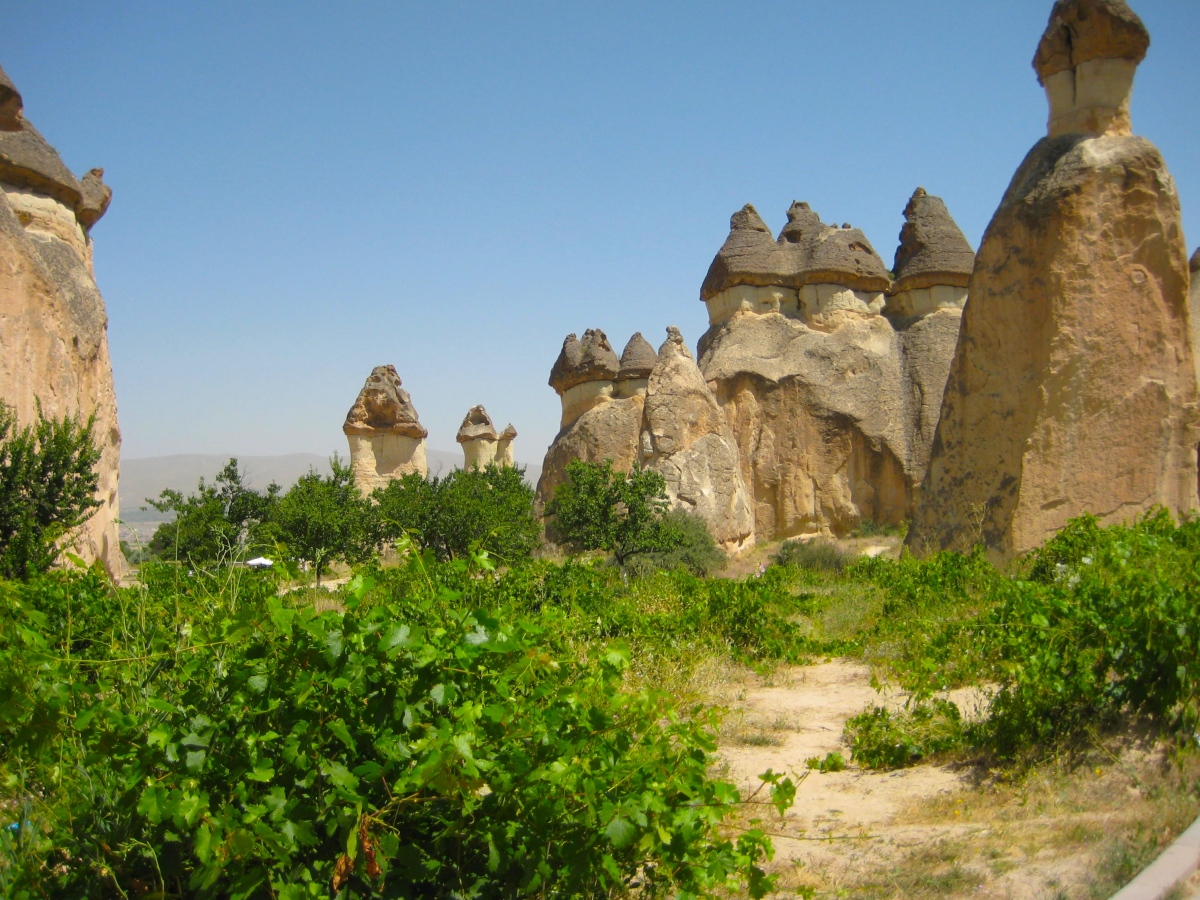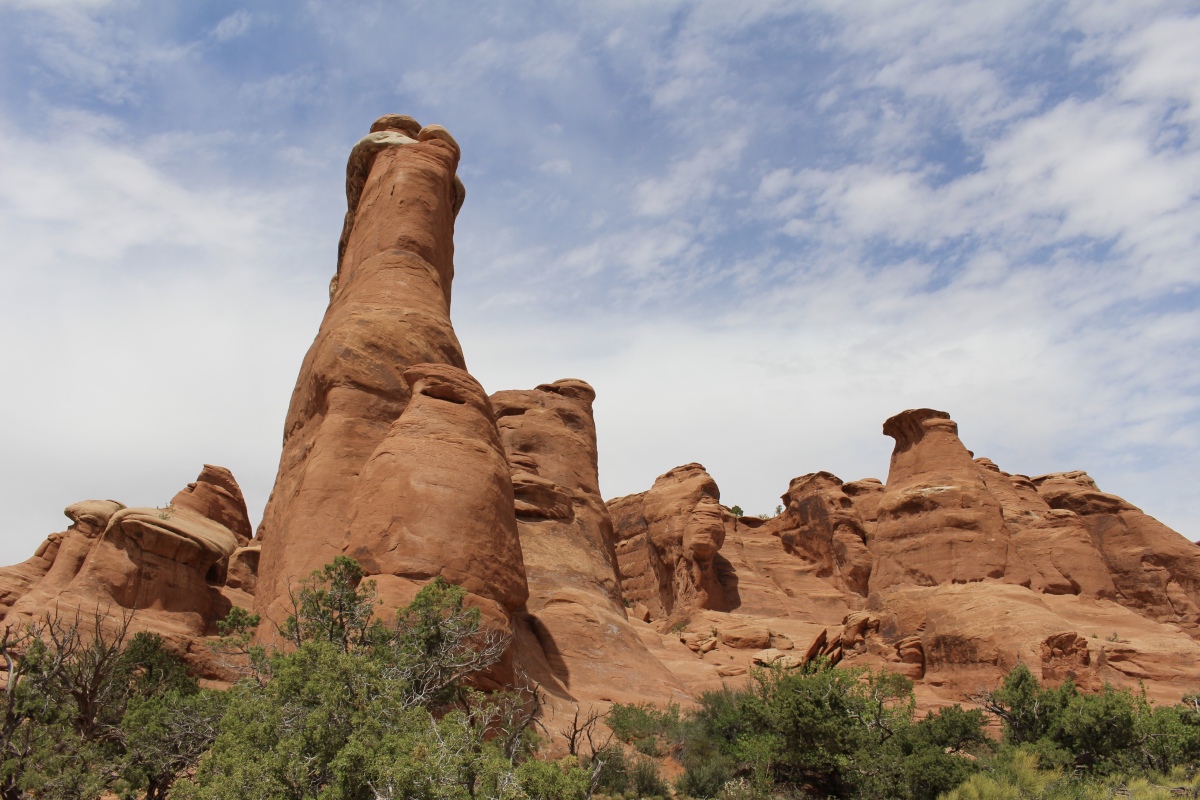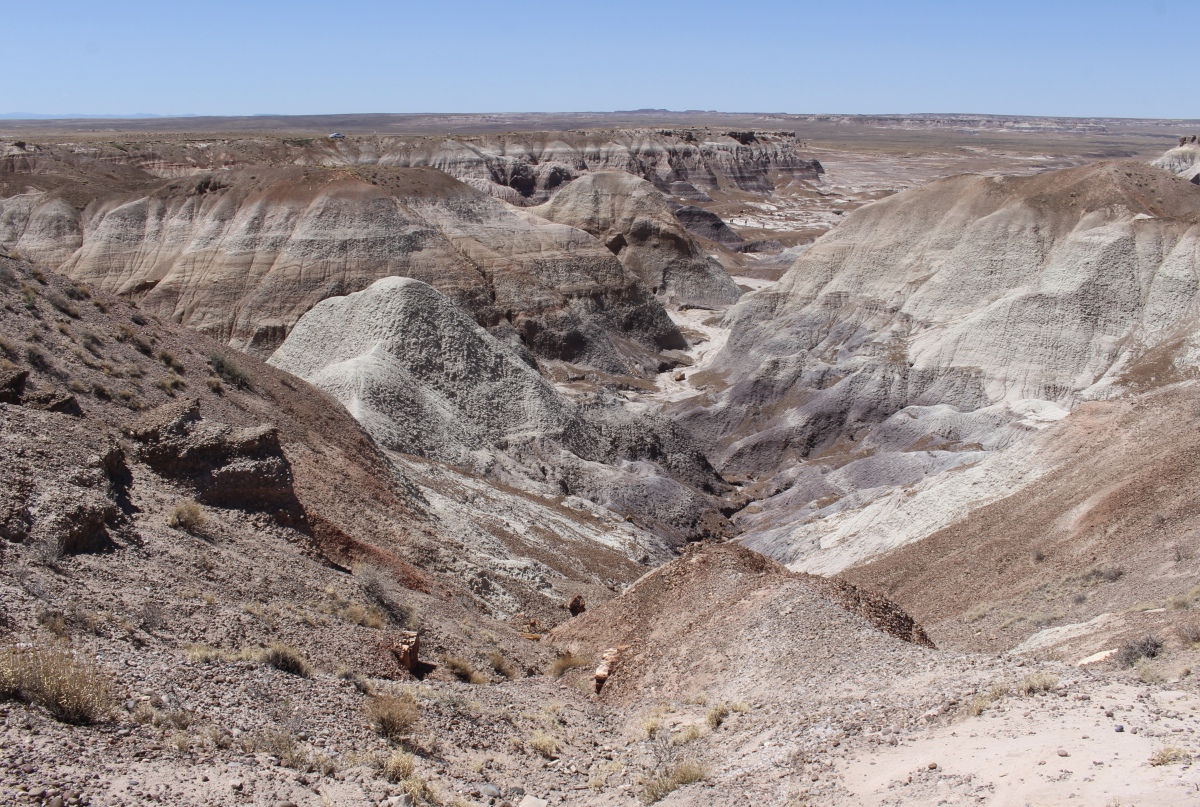My strange collection of hoodoos and badlands is growing. I encountered my first hoodoos, called fairy chimneys, in Cappadocia, Turkey in 2010. In the Four Corners area, I encountered both hoodoos and badlands in Utah, Arizona, and New Mexico. I still haven’t seen some of the most iconic hoodoos at Bryce National Park or elsewhere in the world.
What exactly is a hoodoo? I’m no scientist, but it seems hoodoos also go by the names of tent rocks, fairy chimneys or earth pyramids. They’re tall thin pillars of rock that protrude usually from the bottom of an arid basin or badland, most often in desert areas. The pillar normally consists of soft rock topped by harder, less easily eroded stone that protects the column from the elements. Hoodoos have a variable thickness, and are often described as having a totem-pole shaped body.
Badlands are a dry terrain where softer sedimentary rocks and clay-rich soils have been eroded extensively by wind and water. They are characterized by steep slopes and minimal vegetation; they commonly include canyons, ravines, gullies, buttes, mesas and hoodoos. They are often difficult to navigate by foot.

Devrent Imagination Valley in Cappadocia

Fairy Chimneys in Cappadocia

Fairy Chimneys in Cappadocia

Cappadocia

ballooning through Cappadocia
Arches National Park is mostly known for its fabulous arches, but it also has its share of hoodoos.

Hoodoos at Arches National Park

Hoodoos at Arches National Park

Hoodoos at Arches
In Coal Mine Canyon near Tuba City, Arizona, I encountered a whole canyon full of rust-and-white striped hoodoos.

hoodoos in Coal Mine Canyon, Arizona

Coal Mine Canyon, AZ

Coal Mine Canyon
Blue Mesa at Petrified Forest National Park in Arizona is badlands area. Badlands are found around the world, usually in arid regions where poorly consolidated rock undergoes infrequent but torrential rain. The soft rock funnels quantities of water down rills, gullies and washes, the water carrying loads of sediment away. Bentonite clay within the formation can swell up with moisture, shrinking and cracking as it dries, creating an “elephant-skin surface.” Beneath the surface, an intricate maze of natural pipes and spaces form within the badlands. Clues to this hidden natural plumbing manifests on the face of the badlands as dimples in the ground, sinks, slumps and seeps. As erosion continues, caves and natural bridges can form as the spaces are exposed. Erosion creates new features every year.

Blue Mesa

Blue Mesa

Blue Mesa

Blue Mesa
Finally, The Bisti/De-Na-Zin Wilderness in New Mexico is a rolling landscape of badlands. Time and natural elements have etched a fantasy world of strange rock formations. The weathering of the sandstone forms hoodoos – weathered rock in the form of pinnacles, spires, cap rocks, and other unusual forms.
Bisti/De-Na-Zin Wilderness Translated from the Navajo language, Bisti (Bis-tie) means “a large area of shale hills.” De-Na-Zin (Deh-nah-zin) takes its name from the Navajo words for “cranes.”

Hoodoos at Bisti

Hoodoos at Bisti

Hoodoos at Bisti

Hoodoos at Bisti
*********************
“PHOTOGRAPHY” INVITATION: I invite you to create a photography intention and then create a blog post for a place you have visited. Alternately, you can post a thematic post about a place, photos of whatever you discovered that set your heart afire. You can also do a thematic post of something you have found throughout all your travels: churches, doors, people reading, people hiking, mountains, patterns, all black & white, whatever!
You probably have your own ideas about this, but in case you’d like some ideas, you can visit my page: photography inspiration.
I challenge you to post no more than 20 photos (fewer is better) and to write less than 350-500 words about any travel-related photography intention you set for yourself. Include the link in the comments below by Thursday, August 30 at 1:00 p.m. EST. When I write my scheduled post in response to this challenge on Thursday, September 6, I’ll include your links in that post. If you link after August 30, I will not be able to include your link in my next post, so please feel free to add your link to that post as soon as it publishes (since I’m leaving for the Camino on August 31).
This will be an ongoing invitation, every first and third Thursday of each month. Feel free to jump in at any time. 🙂
I hope you’ll join in our community. I look forward to reading your posts!





This extraordinary world we live in, Cathy! And you’ve certainly seen your share. 🙂 🙂 Thanks for the explanations and the ‘wicked’ photography! Hugs, darlin!
LikeLiked by 1 person
It is a crazy world, Jo. You never know what you’ll find around any corner. Hugs to you too, Jo. xx
LikeLiked by 1 person
Well, I’ve learnt something new!
LikeLike
Thanks, Sue. Me too!
LikeLiked by 1 person
😊😊
LikeLike
What an amazing post Cathy. Those formations are just mind blowing. I never knew the explanation of hoo -doos I thought it had something to do with black magic and as for bad lands I thought they were something from a western movie. So thank you for explaining it.
LikeLike
Haha, I never really knew what they were either until I visited these places and learned a thing or two myself. Travel teaches you so much, doesn’t it?
LikeLiked by 1 person
Such amazing landscapes that are captivating. That place in Turkey so resembles Kasha-Katuwe Tent Rocks in New Mexico. I never tire of these unique sights!
LikeLike
I haven’t been to Kasha-Katuwe Tent Rocks in New Mexico, Ingrid. I guess I need to add that to my list! I love these kinds of formations too. 🙂
LikeLiked by 1 person
I LOVE viewing your photos. They’re so good I feel like I can almost touch those hoodoos. I’ve never spent time in this part of the country, but certainly hope to.
LikeLike
Thanks so much, Pam. I’m glad you like them. I hope you’ll make it here one day. There are so many places to visit in this country and in the world!
LikeLiked by 1 person
Beautiful photographs! I had heard of Cappadocia in Turkey but Hoodoos (sounds so much like voodoo) in Bisti took me by surprise. It was like a set from a Star Wars film. I really enjoyed going through this post and yes, I’m envious too. I can imagine how magnificent it all must feel to see in person.
LikeLike
Thank you so much. Those hoodoos in Bisti were out in the middle of nowhere and I don’t feel I did them justice. I’d seen photos of them at sunset in an area where they were more dense, but I didn’t find that area and I wasn’t there at sunset. I wish I had been. It definitely looks like a set from Star Wars, and was fun to see in person.
Thanks for dropping by and commenting. 🙂
LikeLiked by 1 person
Greetings from Lower Bavaria where it looks much different and greener!
LikeLike
Greetings back to you, Ulli. I’m glad you’re in greener lands. Have fun. 🙂
LikeLiked by 1 person
Nature’s sculptures are so magnificent. I have been fortunate to see the hoodoos of Bryce Canyon, but you have shown me many more interesting and beautiful sites.
LikeLike
Bryce Canyon and Zion are on our list for some future date, Jude. I love these sculptures too. 🙂
LikeLiked by 1 person
YOur hoodoos reminded me of Cappadochia and then I scroll down and find them!
LikeLike
When I looked at my collection from the Four Corners, I also immediately thought of Cappadocia, and went in search of them. Thanks, Gilly. 🙂
LikeLike
I really love this sort of landscape. Great pictures.
LikeLike
Me too, Anabel. I’m glad you liked them. 🙂
LikeLiked by 1 person
Thanks for teaching me something, Cathy. I’ve seen many photographs of badlands but never known that “Erosion creates new features every year.” I always thought that what I saw was static.
LikeLike
You’re welcome, Linda. That’s one thing I love about traveling is that you always learn something new along the way. 🙂
LikeLiked by 1 person
I like the idea of contrasting the different hoodoos and badlands….love those Cappadocia images….and Bisti, that looks wonderful. I’d never heard of it. We saw hoodoos unexpectedly in a wash as we headed towards a river in Nevada, outside Vegas. And assorted badlands beauty in Arizona. The southwest never stops with its sculptured landscape.
LikeLike
Thanks, Lynn. Bisti was probably one of the most disappointing places I went. I had seen photos of the hoodoos at sunset online, but I could never find a spot where the hoodoos were concentrated. Neither could I be there at sunset because of my itinerary. It’s managed by the Bureau of Land Management, so no one is there to help you find your way around. I agree the Southwest sculpted landscapes never fail to surprise and impress. 🙂
LikeLike
[…] ~wander.essence~ | Photography […]
LikeLike